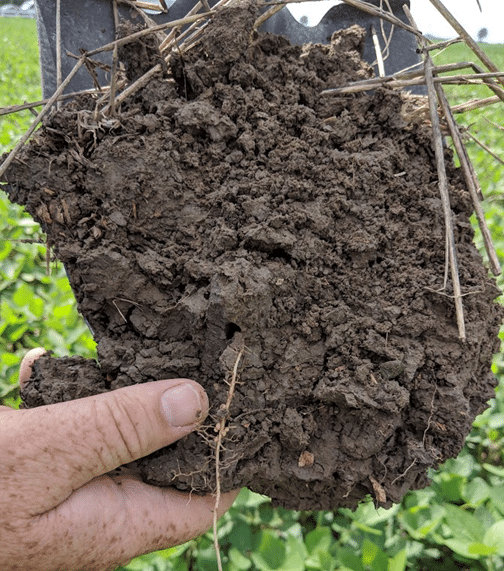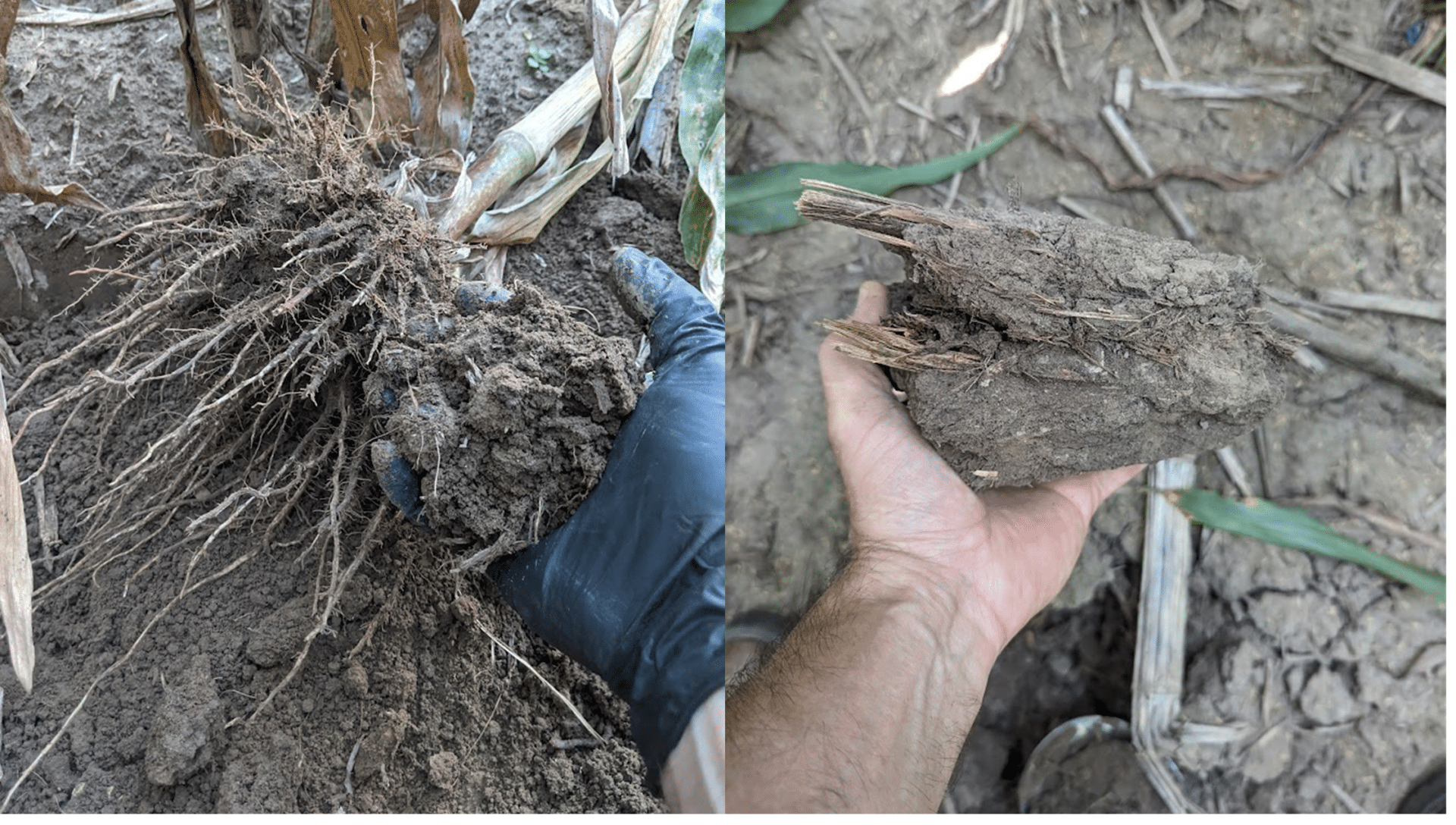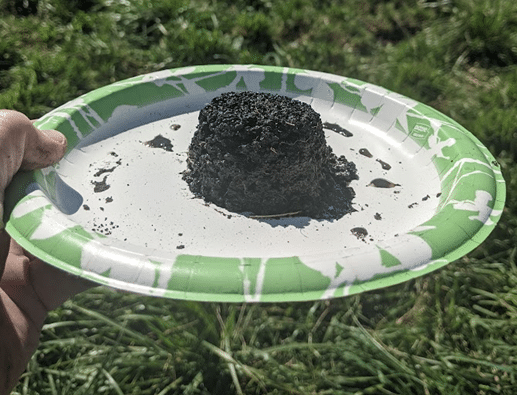
Soil compaction is the most common problem that I have encountered on farms as I travel across the Midwest. It is so prevalent that it’s easy to forget that compaction is a symptom, not an inherent property of soil. It is the result of poor soil function, which is the result of management practices that inhibit soil aggregation.
Soil aggregates are the building blocks of healthy soil. Well-aggregated soil has a crumb structure that gives it a “cottage cheese” or “chocolate cake” look. Aggregation allows the soil to breathe and water to infiltrate rather than running off the surface. There are only two things that provide the glue to hold aggregates together, and both involve biology. The first is biotic glues from soil organisms. One scientific term for biotic glues is extracellular polymeric substances, but that doesn’t exactly roll off the tongue. I prefer “dead microbe goo.” This category also includes glomalin, a sticky protein that is produced by arbuscular mycorrhizal fungi (AMF).
The second thing that helps create aggregation is plant root exudates. Exudates are essentially liquid carbon compounds that feed soil biology. Root exudates also glue tiny aggregates (aka microaggregates) together, whereas AMF does the job of stitching the microaggregates together to form macroaggregates. Those macroaggregates are what provide the chocolate cake look to a healthy soil.

It is important to note that the plants will produce far less root exudates if they are being fed routinely with applied fertilizers and manures. With less root exudate production, the microaggregates are not formed and the soil microbes are not fed. If the soil microbes are not fed, then they (i.e., AMF) are not producing biotic glues to form macroaggregates and they are not feeding nutrients from the soil to the plants.
So, what does all of this have to do with compaction? The glues that hold aggregates together are what provide the soil strength and resistance to compaction that we want in our fields. A well-aggregated soil will compact less under load, even when it is wetter, than a poorly aggregated soil.
The lack of living ground cover is the main culprit in soil collapse. A living plant is the only thing that can provide the conditions for aggregate formation – root exudation and a food source for AMF. There are no mechanical interventions or engineering fixes that allow humans to replicate this process. Plants are the only game in town when it comes to preventing and successfully remediating compaction in the long term. Tillage can temporarily mask the symptoms of compaction, but tillage is also the bane of an aggregate’s existence. Tilling the soil shreds aggregates and disrupts AMF, which are a major driver of aggregate formation.

The photos above show a real-world example of what can happen when tillage and a lack of living roots are combined. The field had an overwintering cover crop in 2021 and was planted no-till in 2022. Due to an equipment breakdown, there was no overwintering cover crop planted in the fall of 2022 and it was tilled in the spring of 2023. Nutrient management was the same in both years. In the summer of 2022, the soil was crumbly and relatively well aggregated and had a nice earthy smell. By the summer of 2023, the same spot was poorly aggregated, compacted and smelled putrid. The system went backwards, and the soil is now very susceptible to compaction during fall harvest.
Excessive applications of nitrogen are another common culprit that can cause soil structure to collapse. Adding too much readily available inorganic nitrogen alters the carbon to nitrogen ratio in the soil. A balanced food source for soil microbes has a carbon to nitrogen ratio of approximately 24:1. A higher ratio indicates that the microbes have access to more carbon and/or less nitrogen than they need to grow and reproduce. A lower ratio indicates the opposite. Most commercial nitrogen products and liquid livestock manures contain little to no carbon and a lot of readily available nitrogen. If nitrogen is overapplied and soil microbes have access to more nitrogen they need, they will multiply rapidly and start consuming more carbon. Where does that carbon come from? Crop residue, organic matter, root exudates, and biotic glues – the very things that we need to maintain aggregation. As noted above, excess available nutrients in the root zone also inhibits root exudation, reducing availability of carbon even more and further compounding the problem.
Growing a monoculture legume crop can have the same effect on soil structure. Legumes fix nitrogen and legume residues tend to have lower C:N ratios than grass crops or diverse plantings. Fixing nitrogen with legumes is a good thing, but we need to keep in mind the tradeoffs. The potential negative effects can be offset with diverse mixes that will better capture and recycle the nitrogen in organic form for slower release to the following crop.
Our first rule when dealing with compaction should be: “Do no harm to soil aggregates.” On average, aggregates only hold together for three to four weeks in the soil. Biotic glues are constantly being broken down and replenished as part of the cycle of life (and death) in the soil. This is why it is so critical to maintain a living root in the soil for as long as possible throughout the year. Mycorrhizal fungi cannot survive without root exudates. Living roots need to be priority #1 in any management system that seeks to minimize the effects of compaction. Minimizing soil disturbance, both physical and chemical, is also critical.
In Part 2 of this series, we will investigate some tools and techniques for minimizing damage and yield loss from compaction while you work to build a healthy, resilient soil. We can beat compaction naturally when we “stick” with it.

